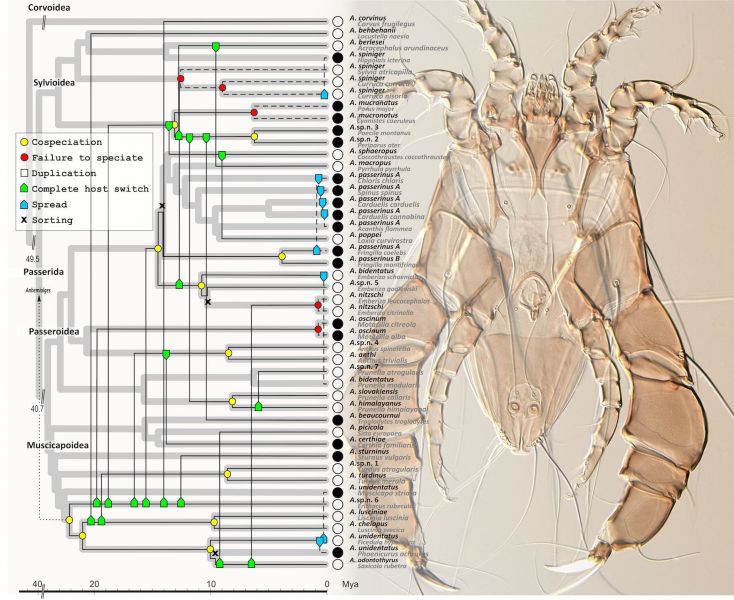Jacek Dabert, Serge V Mironov, Miroslawa Dabert, The explosive radiation, intense host-shifts and long-term failure to speciate in the evolutionary history of the feather mite genus Analges (Acariformes: Analgidae) from European passerines, Zoological Journal of the Linnean Society (2021) pp. zlab057
Mites of the genus Analges (Acariformes: Analgidae) are one of the numerous evolutionary lines of the so-called feather mites, of which several thousand species are parasites or commensals of birds. They are related to the dust mites which can cause allergies in humans. It is usually believed that feather mites coevolve with their hosts because they are transmitted by direct body contact between birds. In effect, there originate monoxenous mite species that live only on a single, specific bird species.
Analges belongs to a specific group of mites that have adapted to life on down feathers in the deep plumage layers of passerine birds (Passeriformes), the most numerous group of birds, which includes most of the species of birds that we meet every day, including sparrows, tits, rooks and many songbirds in the gardens. The Analges mites show unusual body modifications, allowing them to clutch firmly on the feathers and move slowly with the four anterior legs among the soft threads of down feathers, somewhat reminiscent of “sluggish” gibbons. The evolutionary history of these mites and the course of a possible parallel evolution between them and their hosts have hitherto been completely unknown. We decided to unravel this story together with our long-term collaborator, prof. Sergey V. Mironov from the Institute of Zoology, Russian Academy of Sciences in St. Petersburg, a world-class specialist in the systematics and morphology of feather mites. Using morphological data and DNA sequences, we have shown that the current taxonomic hypotheses dividing the genus into subgenera (Analges and Analgopsis) or dividing some species into species groups (chelopus and passerinus) are false. In addition, our molecular data revealed seven new cryptic species, i.e., species that are morphologically indistinguishable. In addition, we have confirmed the real existence of several multi-host species, i.e., those that inhabit several different host species. According to molecular dating, the origin of Analges (about 41 million years ago) coincided with the Eocene differentiation of the Passerida suborder into the Sylvioidea superfamily (which includes, among others, warblers and tits) and the Muscicapoidea-Passeroidea line (grouping, among others, flycatchers, nightingales, finches and sparrows). Our analysis shows that the first species of the genus Analges arose on birds of the Muscicapoidea, while remaining passerine superfamilies appear to have been colonized by mites that changed their hosts. Cospeciation of hosts and parasites appears to be relatively common among Analges species and their hosts, but the most striking pattern in the scenario of the common evolutionary history (cophylogenesis) of these animals involves surprisingly numerous host changes and a few so-called failures to speciate. This last term describes a duration of the same species for a long time, in some Analges species counted in millions of years, on several closely related host species. This is an astonishing result in the light of previous research on feather mites, which rather indicated a significant resemblance of the evolutionary history of birds and their mites. The mechanism of long-term gene flow between different populations of multi-host Analges species, which is necessary for the same species to inhabit different hosts over and over, is enigmatic and difficult to resolve at this stage of research.
Presumably, in some cases mites, which themselves have very limited dispersibility, could be transferred between birds via feathers used as nest material. This explains the presence of the same species, e.g. Analges passerinus, on different host species (here finch, common greenfinch, siskin, goldfinch, redfinch and mackerel), which use feathers to build their nests. However, this requires a selective feather use by birds, a phenomenon so far unexplored.


